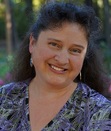S.P. Sipal's Blog, page 13
January 16, 2015
The Snake and the Wand -- Are They Related?
Can you think of a more cliched article of fantasy writing than the wand? What witch, warlock, mage, or sorcerer would not be properly attired without the final touch of this powerful weapon, whether it be a traditional stick of wood or a staff of power...or perhaps even a light saber.
I've been fascinated recently with the wand and its origins. While some people believe the origins of the wand lie in a symbolic representation of masculine power, a phallic symbol, I've been pondering another source. This is the result of the major edits I just finished with Southern Fried Wiccan , which is releasing in March. One of the things I had to work on to get just right was my description of an ancient goddess who gets some screen time on the page (in her mini-sculpture form).
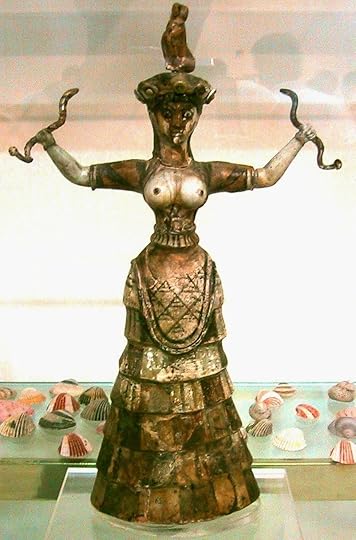 The Snake Goddess of Crete (from ~1600 BCE) is an awesome example of the power of the goddess in antiquity. Not only is she holding two snakes, but she holds them upright, in a display of power, with her breasts -- her female reproductive and nurturing power -- fully bare. She is not a goddess to mess with.
The Snake Goddess of Crete (from ~1600 BCE) is an awesome example of the power of the goddess in antiquity. Not only is she holding two snakes, but she holds them upright, in a display of power, with her breasts -- her female reproductive and nurturing power -- fully bare. She is not a goddess to mess with.
But it is the way she holds the snakes that got me thinking about other early examples of snakes used as rods of power and their origin.
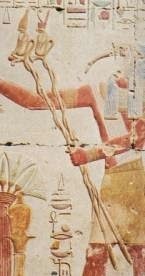 Look at this example of a couple of royal serpents on a staff carried by Thoth, the ancient Egyptian god of knowledge and writing (yes!).
Look at this example of a couple of royal serpents on a staff carried by Thoth, the ancient Egyptian god of knowledge and writing (yes!).
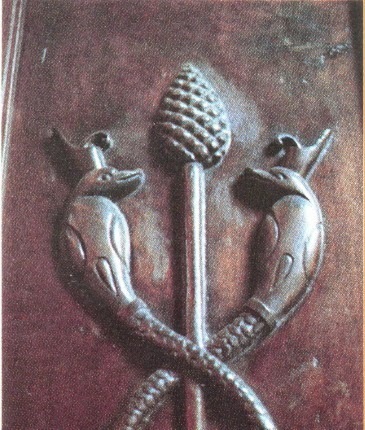 Or this one of a pine cone staff associated with the Egyptian god, Osiris, god of the dead.
Or this one of a pine cone staff associated with the Egyptian god, Osiris, god of the dead.
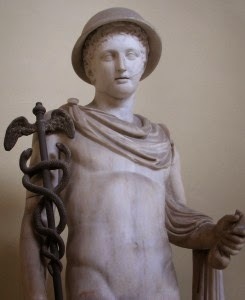 There were many examples of snakes wrapped around sticks from ancient Babylonia and Egypt which eventually made their way into the representation of the caduceus of Hermes.
There were many examples of snakes wrapped around sticks from ancient Babylonia and Egypt which eventually made their way into the representation of the caduceus of Hermes.
Other examples :
the snake on the Tree of Life in the Garden of Eden (admittedly, a rather large staff) the staff of Moses and the pharaoh's magicians, which turn to serpents as an example of their powerthe Babylonian god Ningizzida represented by two snakes entwined around a staff
Many of these symbols were not only associated with power, but with medicine and healing as well Handling snakes has long been a dangerous, but in many areas of the world, a necessary occupation. The snake handlers of India are still called upon in rural villages to remove venomous vipers from people's home. Even today in Appalachia, the tradition of snake handling is still practiced in some churches. Those who fear the snake (me!) look with awe on anyone who is fearless enough to engage them with their bare hands.
We know that snake worship was practiced in many ancient societies, and most believe it was due to the snake's symbolic nature of death and renewal through the shedding of its skin, plus it's representation with the underworld as it lives underground. But from a real practical viewpoint, I wonder -- did the wand originate from snake handling? Is that why so many of the earliest depictions of wands and royal staffs frequently incorporate a serpent image as well? Perhaps people, even in ancient times, who wanted to adopt the power of the snake charmer without...you know...actually touching a snake, picked up a stick and magically assumed its power.
What do you think?
I've been fascinated recently with the wand and its origins. While some people believe the origins of the wand lie in a symbolic representation of masculine power, a phallic symbol, I've been pondering another source. This is the result of the major edits I just finished with Southern Fried Wiccan , which is releasing in March. One of the things I had to work on to get just right was my description of an ancient goddess who gets some screen time on the page (in her mini-sculpture form).
 The Snake Goddess of Crete (from ~1600 BCE) is an awesome example of the power of the goddess in antiquity. Not only is she holding two snakes, but she holds them upright, in a display of power, with her breasts -- her female reproductive and nurturing power -- fully bare. She is not a goddess to mess with.
The Snake Goddess of Crete (from ~1600 BCE) is an awesome example of the power of the goddess in antiquity. Not only is she holding two snakes, but she holds them upright, in a display of power, with her breasts -- her female reproductive and nurturing power -- fully bare. She is not a goddess to mess with.But it is the way she holds the snakes that got me thinking about other early examples of snakes used as rods of power and their origin.
 Look at this example of a couple of royal serpents on a staff carried by Thoth, the ancient Egyptian god of knowledge and writing (yes!).
Look at this example of a couple of royal serpents on a staff carried by Thoth, the ancient Egyptian god of knowledge and writing (yes!). Or this one of a pine cone staff associated with the Egyptian god, Osiris, god of the dead.
Or this one of a pine cone staff associated with the Egyptian god, Osiris, god of the dead. There were many examples of snakes wrapped around sticks from ancient Babylonia and Egypt which eventually made their way into the representation of the caduceus of Hermes.
There were many examples of snakes wrapped around sticks from ancient Babylonia and Egypt which eventually made their way into the representation of the caduceus of Hermes.Other examples :
the snake on the Tree of Life in the Garden of Eden (admittedly, a rather large staff) the staff of Moses and the pharaoh's magicians, which turn to serpents as an example of their powerthe Babylonian god Ningizzida represented by two snakes entwined around a staff
Many of these symbols were not only associated with power, but with medicine and healing as well Handling snakes has long been a dangerous, but in many areas of the world, a necessary occupation. The snake handlers of India are still called upon in rural villages to remove venomous vipers from people's home. Even today in Appalachia, the tradition of snake handling is still practiced in some churches. Those who fear the snake (me!) look with awe on anyone who is fearless enough to engage them with their bare hands.
We know that snake worship was practiced in many ancient societies, and most believe it was due to the snake's symbolic nature of death and renewal through the shedding of its skin, plus it's representation with the underworld as it lives underground. But from a real practical viewpoint, I wonder -- did the wand originate from snake handling? Is that why so many of the earliest depictions of wands and royal staffs frequently incorporate a serpent image as well? Perhaps people, even in ancient times, who wanted to adopt the power of the snake charmer without...you know...actually touching a snake, picked up a stick and magically assumed its power.
What do you think?
Published on January 16, 2015 07:07
January 13, 2015
The Oppositional Role of Dumbledore to Hagrid in Harry's Development
Potter fans rejoice! The release date for the upcoming Fantastic Beasts and Where to Find Them movie was announced this week. We only have 1 yr, 10 months, 4 days, and (as of this posting) 14 hours to wait. And with waiting, to examine and over analyze every detail Jo releases.
So it's time for me to stop slouching around this blog and get back into the game. Hopefully Pottermore will give us some clues to go on. After all, FBWFT will be set in the same universe, if not the same time period as Potterdom, and Newt was Luna's great grandfather-in-law. ;-) Plus, Jo has finally gotten on board with Twitter and has been releasing clues there.
But, in trolling through Pottermore for the few juicy nuggets Jo gives us regarding the mythical subtext of her series, I was thrilled to come across this bit:
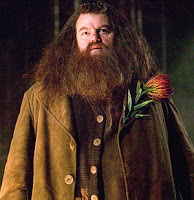 I was thrilled! Thrilled I tell you to read this...and have been meaning to write about it for quite a while. While many Harry Potter analysts have long understood the
I was thrilled! Thrilled I tell you to read this...and have been meaning to write about it for quite a while. While many Harry Potter analysts have long understood the
Using Geomancy to Divine Jo's World :
In "Geomancy and Alchemy in Harry Potter," I used Jo's Gryffindor passwords of Caput Draconis and Fortuna Major to analyze how Jo was weaving secrets from geomancy into her story...particularly the opposing nature of Rubeus Hagrid to Albus Dumbledore.
Geomancy was a form of divination particularly popular during the Middle Ages and early Renaissance. It was compased of 16 opposing characters divided into eight pairs of opposites which were used to determine the fate of the question asked. Albus and Rubeus were one set of these opposing characters, defined like this:
My Analysis (from 2004) and What This Means for Harry
As we know now, Aberforth, while not a twin, definitely played a strong role in Deathly Hallows. And while Hagrid was not on top of the Astronomy tower when Dumbledore was killed, he did battle the Death Eaters as they fled and set fire to his hut.
In JK Rowling's deft hands, character names are more than just a reflection of the personality of its owner. But JKR's talent was not just in giving her characters a whimsical, though accessible, name which made them seem fully a part of their magical world. It was most importantly her ability to craft a name which carried hints of the mystery surrounding that character that intrigued her rabid audience.
As we start getting names for Fantastic Beasts and Where to Find Them, and hints of the plot, we should also be able to dig below the surface and discover some of the mysteries Jo will be developing for this new series.
Let the games begin!
Note: The full "Geomancy and Alchemy Gems in Harry Potter" is way too long to reproduce on a blog. But if you're interested it's been on the web here for quite some time.
Photo credit
So it's time for me to stop slouching around this blog and get back into the game. Hopefully Pottermore will give us some clues to go on. After all, FBWFT will be set in the same universe, if not the same time period as Potterdom, and Newt was Luna's great grandfather-in-law. ;-) Plus, Jo has finally gotten on board with Twitter and has been releasing clues there.
But, in trolling through Pottermore for the few juicy nuggets Jo gives us regarding the mythical subtext of her series, I was thrilled to come across this bit:
Colours also played their part in the naming of Hagrid and Dumbledore, whose first names are Rubeus (red) and Albus (white) respectively. The choice was a nod to alchemy, which is so important in the first Harry Potter book, where ‘the red’ and ‘the white’ are essential mystical components of the process. The symbolism of the colours in this context has mystic meaning, representing different stages of the alchemic process (which many people associate with a spiritual transformation). Where my two characters were concerned, I named them for the alchemical colours to convey their opposing but complementary natures: red meaning passion (or emotion); white for asceticism; Hagrid being the earthy, warm, physical man, lord of the forest; Dumbledore the spiritual theoretician, brilliant, idealized and somewhat detached. Each is a necessary counterpoint to the other as Harry seeks father figures in his new world.
 I was thrilled! Thrilled I tell you to read this...and have been meaning to write about it for quite a while. While many Harry Potter analysts have long understood the
I was thrilled! Thrilled I tell you to read this...and have been meaning to write about it for quite a while. While many Harry Potter analysts have long understood the Using Geomancy to Divine Jo's World :
In "Geomancy and Alchemy in Harry Potter," I used Jo's Gryffindor passwords of Caput Draconis and Fortuna Major to analyze how Jo was weaving secrets from geomancy into her story...particularly the opposing nature of Rubeus Hagrid to Albus Dumbledore.
Geomancy was a form of divination particularly popular during the Middle Ages and early Renaissance. It was compased of 16 opposing characters divided into eight pairs of opposites which were used to determine the fate of the question asked. Albus and Rubeus were one set of these opposing characters, defined like this:
Albus and Rubeus form one set of opposing figures. Albus (White) represents peace, wisdom, and purity, while Rubeus (Red) indicates passion, power, and violence.
Albus (White) Rubeus (Red) Planet/Element Mercury/ Earth Mars/ Fire Sign/Element Gemini/ Air Scorpio/ Water Character Peace-loving, honest, pure, and charitable. "Hot, passionate, and fond of strong language. Tends to stir up trouble." (Greer 44) Description "Illumination, wisdom…Spiritual growth and harmony. Patience, thoughtfulness and the ability to balance all areas of life." (SerenaPowers.com)
Related to intellect and mysticism. "Rubeus is a figure of passion and involvement in life, balancing the abstract detachment of Albus” (Greer 44).
Rugged and emotional.Good with agriculture and animals.
Note: This chart bases the planet, element, and sign attributions according to Henry Cornelius Agrippa--who as coincidencewould have it, Ron mentioned three times (SS102) on the Hogwarts Express in his desire to collect Agrippa's Chocolate Frog card. Agrippa, an alchemist of the sixteenth century, was both feared and revered in his day as a sorcerer. He was most famous for his book Occult Philosophy, in which "Of Geomancy" was a part.
Albus is considered a positive figure, while Rubeus is negative--meaning if Albus appears in your geomantic chart in regard to a question, the outcome you seek is usually favorable, whereas if Rubeus appears, except in certain situations (love, war, and agriculture), your answer is unfavorable.Now, keep in mind that I was writing this back in 2004, when Order of the Phoenix had just been released, when you read my own divination for how this opposing nature could play out:
My Analysis (from 2004) and What This Means for Harry
In my opinion, while I do suspect Hagrid has a darker and more powerfully magical side than he is given credit for, and while I think it entirely possible Dumbledore is not quite the god-like all-knowing wizard when it comes to deciphering others' characters (I think he tends to see their potential rather than the reality), in the end it is my belief that these two characters are as upfront as they appear to be.
What I believe Ms. Rowling has done with the geomantic opposites of Albus and Rubeus is to show two sides of the same coin. Even though Dumbledore and Hagrid are diametrically opposed, they’re on the same team. They will fight side by side. Yet, their personalities are complementary.
This dichotomy suits their relationship with Harry just perfectly. Each offers a fatherly example to Harry in his own way. Harry can garner their different strengths and go to each for his own brand of support and understanding. As always, diversity contributes to growth. In this case, to Harry's growth.
What do I think will happen in the last book of the septology based on this geomantic interpretation? I believe that before the end of the series, Dumbledore and Hagrid will possibly come into direct conflict. More than likely, the subject will be Harry and his best interests (much like was covered in OotP by the bickering between Mrs. Weasley and Sirius). I think it entirely possible Hagrid will figure into a death threat against Dumbledore--hopefully by saving Dumbledore's life.
Finally, just a side note of interest--the zodiac sign associated with geomantic Albus is Gemini. Gemini is, of course, the twin. Could Albus and Aberforth be twins? And if so, how would that relate to the septology? Will Aberforth play a more prominent role in the last book with the removal of his brother? And if so, what type of role?
As we know now, Aberforth, while not a twin, definitely played a strong role in Deathly Hallows. And while Hagrid was not on top of the Astronomy tower when Dumbledore was killed, he did battle the Death Eaters as they fled and set fire to his hut.
In JK Rowling's deft hands, character names are more than just a reflection of the personality of its owner. But JKR's talent was not just in giving her characters a whimsical, though accessible, name which made them seem fully a part of their magical world. It was most importantly her ability to craft a name which carried hints of the mystery surrounding that character that intrigued her rabid audience.
As we start getting names for Fantastic Beasts and Where to Find Them, and hints of the plot, we should also be able to dig below the surface and discover some of the mysteries Jo will be developing for this new series.
Let the games begin!
Note: The full "Geomancy and Alchemy Gems in Harry Potter" is way too long to reproduce on a blog. But if you're interested it's been on the web here for quite some time.
Photo credit
Published on January 13, 2015 07:44
November 6, 2014
Walking While Writing Through NaNoWriMo part 3
Daily nanoWALmo Stats:
1:45 hours of walking with over 7000 steps and 1969 words written!
I'm continuing to really enjoy this process of walking while writing that I've talked about earlier on the blog. Maybe I'm being overly optimistic, but I'm hoping walking with voice recognition will be a method I'll continue to employ past November to increase my writing, not just with novels but with blog posts, email, etc.
Two more updates on the process I want to mention .
As Carla Richards reminded me, when you use Dragon for voice recognition, it comes with an audio recording of your dictation sessions which allows ease of editing as you can replay and hear what you actually said. I'd forgotten this feature as it's been a while since I used it, but it is indeed very useful. Neither Carla nor I are aware of a mobile voice recognition software that offers an audio recording, but if you know of one, please let me know.Another benefit I'm discovering with voice recognition over my typing is that it spells a lot better than I do! :-)
Along with these (mostly) daily updates I'm giving regarding my progress, I thought it might also be nice to share a bit of writerly inspiration, as long as I keep it short so we can all get back to writing. I'll start by recycling a few prior NaNo posts from a couple of years ago while they last.
First up, and this may seem a bit odd, but I want to focus on failure. Not all of us will complete NaNo, and that's ok. Many of us may also be frustrated by where we are in our writing journeys, worried that we haven't yet gotten that agent, editor, multi-book contract, NYT listing....
But I want to share some of my favorite words from JK Rowling. These words of wisdom actually do not come from a Harry Potter novel but from her commencement address at Harvard in 2008 (bolded highlights are my addition):
I think it fair to say that by any conventional measure, a mere seven years after my graduation day, I had failed on an epic scale. An exceptionally short-lived marriage had imploded, and I was jobless, a lone parent, and as poor as it is possible to be in modern Britain, without being homeless. The fears that my parents had had for me, and that I had had for myself, had both come to pass, and by every usual standard, I was the biggest failure I knew.
Now, I am not going to stand here and tell you that failure is fun. That period of my life was a dark one...So why do I talk about the benefits of failure? Simply because failure meant a stripping away of the inessential. I stopped pretending to myself that I was anything other than what I was, and began to direct all my energy into finishing the only work that mattered to me. Had I really succeeded at anything else, I might never have found the determination to succeed in the one arena I believed I truly belonged. I was set free, because my greatest fear had been realised, and I was still alive, and I still had a daughter whom I adored, and I had an old typewriter and a big idea. And so rock bottom became the solid foundation on which I rebuilt my life.
You might never fail on the scale I did, but some failure in life is inevitable. It is impossible to live without failing at something, unless you live so cautiously that you might as well not have lived at all – in which case, you fail by default.
Failure gave me an inner security that I had never attained by passing examinations. Failure taught me things about myself that I could have learned no other way. I discovered that I had a strong will, and more discipline than I had suspected; I also found out that I had friends whose value was truly above the price of rubies...
I hope that even if you remember not a single word of mine, you remember those of Seneca, another of those old Romans I met when I fled down the Classics corridor, in retreat from career ladders, in search of ancient wisdom:
As is a tale, so is life: not how long it is, but how good it is, is what matters. (JK Rowling)Rowling's story, both in Harry and in life, is truly inspirational. Especially to writers. If you have not yet, you should read her whole address as she also speaks powerfully of imagination.
As we work our way through NaNoWriMo, let us not be afraid to fail, but afraid of never having tried. And remember that the length is not as important as the content.
How is your NaNoWriMo going ?
Published on November 06, 2014 12:44
November 4, 2014
Using Voice Recognition to Walk and Talk Your Way Through #NaNoWriMo part 2
 Image from TypeWhileWalking.com
Image from TypeWhileWalking.comYesterday I posted the basic premise of my plans for this years NaNoWriMo, to turn the butt-in-chair hands-on-keyboard upside down as I use voice recognition to walk and talk my way through my novel.
I just finished my morning session and logged in 2 hours of walking, 12,000 steps, and 2187 words! And what's so great about it is that I really enjoyed both the walking and dictating. I feel my story is taking off while I keep my health on track.
But after reading back over my post yesterday, I thought I ought to clarify a couple of points to my process. Because I'm hoping some of you will join me as we nanoWALmo through NaNoWriMo!
Dictation Adjustment :
Many people who are trying to dictate their story for the first time will find a period of adjustment as they do so. Fo many writers, this method feels awkward and unnatural.
I faced that with the first story I dictated through Dragon a year ago. But I kept up with it, allowing the pauses I needed to formulate my thoughts before I released the pause button and spoke, and with time I became much more comfortable with the method. This time around, I'm having no such difficulties.
Pacing Vs. Walking :
Since I started writing, I've always used walking as a tool to clear my mind to better focus on my story and brainstorm. There's something to the repetitive motion and brain sloshing that flushes me with serotonin. Or that's my scientific explanation for you. But until last year, I was unable to use walking as a method to actively create.
Now the version of walking I have developed for dictation is truly more pacing than a leisurely stroll through the woods. While I love walking outside, I too easily get caught up noticing everything around me and forget to focus on my story.
I'm much more productive for dictation if I keep myself inside, in scenery that does not distract me. I have a long path that winds through my house that I walk in a circuit. The repetitive motion of the pacing, with time, lulls me into that place of focus that I value so highly.
Voice Quality :
My husband is a Turk, born and raised in Turkey, and has partial hearing loss in both ears. So not only does he have difficulty hearing, but English is his second language. I'm mentioning this here because I learned a long time ago to speak clearly and enunciate distinctly. I think this is why voice recognition works well for me and not for some others. You have to think about your voice quality if you want to make it work.
Flash Editing :
While I do not use the cell and voice recognition to really edit, I do flash edits as I go along. After a paragraph or two, I will slow down and read over what I just dictated for any errors that I will not understand when I settle down to truly edit. I will slow my walking enough to make these quick corrections then continue on. But my focus is only on errors that could be confusing later.
Bluetooth :
Some people may be more comfortable having their hands free and speaking into an ear piece. I'm talking directly into my cell mainly because of the reason above -- I'm giving quick edits as I go. I learned that lesson the hard way with my Paleolithic story when I waited to long to edit and then didn't understand some of the gibberish on the page.
Is anyone else out there dictating their NaNo story? Have you ever used voice recognition for a novel? Would love to hear any tips you have to share.
Published on November 04, 2014 09:15
November 3, 2014
Why Not Add NaNoWalMo to Your NaNoWriMo?
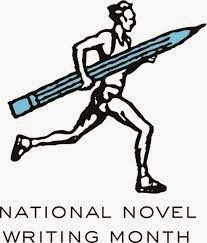
I decided at the very last minute, yesterday morning around 8 am to be exact, to do NaNoWriMo this year. I'd not planned to participate this go around as I've got two edits underway of my own work plus one for the publisher I work for. There is simply no more time in my day. Or so I thought.
One of the key reasons why I changed my mind to give NaNo a go was due to a recent major discovery by me that is probably old news for everyone else out there. But I only entered the 21st century a couple of months ago. My discovery – voice recognition on cell phones these days is so good that it allows me to walk and to talk like an actual lady (meaning at the same time!). Putting Eliza Doolittle aside – I can actually do a lot with my new playtoy. Like even maybe write a novel.
NaNo Does Not Have to Mean Butt-In-Chair :
Traditionally, NaNoWriMo, National Novel Writing Month, is the annual time when many writers plant their butts in a chair for a whole month writing frantically to create a 50,000-word novel before the bell tolls at the end of November. We ignore jobs (as much as possible), house cleaning, cooking, childcare and whatever else you can manage to ignore for the month. Most of us will also spend a lot of that time eating mindlessly as we glance anxiously at our slowly increasing word count, trying to see if we have any prayer of earning that coveted NaNo Winners sticker.
I don't know about you, but butt-in-chair and mindless/quick food eating for a month is a recipe for disaster for me. But it doesn't have to be that way. What my new favorite tool allows me to do is to write and talk at the same time. For myself, I will be adding NaNoWalMo, National Novel Walking Month, into my WriMo with the aid of three important tools.
Toolkit Item #1 – Good Voice Recognition App on Mobile Device :
Voice recognition is so much stronger now than it used to be. As I started playing with my new phone, I discovered it could take dictation for texts and directions perfectly without missing a word, even with my Southern accent. And I thought -- if the voice recognition is this good and I can do it while mobile, why not use it for my writing?
Last time I used voice recognition, it was with the Dragon, and it did not fair so well. I may be unfair to compare the voice recognition in my cell compared to Dragon as the book I was dictating then was a Paleolithic story with lots of unusual words and names. I also made the mistake of dictating long passages before going back to edit. This time around, I'm keeping the names simple, at least while I create, and will stop to edit sooner – before I forget what any weird transcriptions actually meant. (By the way, my phone runs Google Now, though I'm not a tech person and am sure there may be even better programs.)
Toolkit Item #2 – Fitbit (or any pedometer) :
A wonderful friend gave me a Fitbit a few months ago and having that tool really helps motivate me to get more walking into my day. Most people set a goal of 10,000 steps a day, but I shoot for at least 15,000.
As I've already been walking an hour, now that I'm doing NaNoWalMo, I will simply repurpose that hour and use it along with tool #1 to write. I don't have to add any additional time to my day. Since NaNo is all about drafting and not perfection or editing, there's no reason not to use the more mobile if less perfect technology to create my new story.
Not only can I type into my manuscript I can also dictate blog post -- that's way I wrote this. I wrote 1000 words while walking 3000 steps. Editing, however, is another matter. For me, at least, real editing requires butt-in-chair in front of a big screen and keyboard.
Toolkit Item #3 – Crock Pot :
For me, health problems with NaNo are not just about the sitting but also about the food. So, I'm bringing in another beloved tool to help me with that one – my crock pot. I'm sure I'm not the only writer out there who writes better when I feel better. If I let fast and processed foods into my diet for any length of time, brain fuzz will commence and my writing will suffer for it.
Nutrition is an individual matter and everyone needs to know what works for them to keep their brain functioning at its highest level. For me that means no sugar, no wheat flour, few processed food, but lots of veggies and especially the green leafy ones. If I eat this way and do my walking, I will have the clear mind I need to write the best story I can. I like this 3-server crock pot because I can keep 3 healthy foods going, starting them a time that is convenient to me so that I don't start scrounging for the nearest edible thing when I emerge from my writing trance.
Results so Far :
I just started yesterday, but I've got 4,000 words written during an hour walk yesterday and an 1 1/2 hour walk today (which included this blog) with step totals of over 13,000 both days (so far today). The quality of what my voice recognition dictation was great with me only having to slow down periodically to clean up a few problems that I might not recall later when I really sit down to edit.
How About You? :
How many of you have tried alternative methods to butt-in-chair to compose your stories? I know a lot of writers have treadmill desks, which I've long coveted. But with this voice recognition so clear, I'm not sure I need that anymore.
If you're interested, I'll keep this blog rolling throughout the month and post how well I'm doing with the writing and voice recognition walking. Please feel free to share your tips and experience. And maybe we can encourage other writers to NaNoWalMo along with their NaNoWriMo.
UPDATED : Read part 2 of this post at Using Voice Recognition to Walk and Talk Your Way Through NaNoWriMo
Published on November 03, 2014 11:19
October 3, 2014
Giving the Reader More on SavvyAuthors Today
Starting October 13, I will be teaching my workshop on Harry Potter for Writers, at SavvyAuthors. For a taste of what's to come, they are today hosting my blog post - Giving the Reader More, A Glimpse Behind the Veil of JK Rowling's Success. Hope you will check it out!
Published on October 03, 2014 05:56
February 24, 2014
Return to Blog & a Workshop
So...looks like I've been away from this blog much longer than my past breaks. Unfortunately, it was a necessary hiatus. I spent most of 2013 dealing with my aging parents' health issues, which being the long-married couple that they are, they had to have health crises together. :-(
They are all well now and have been for a few months, but it has taken me time to find my way back here. I've got a couple of upcoming posts planned, one Harry Potter related and another about my new love, Paleolithic goddess imagery. But for the moment, I've been prompted to mention a workshop that I'm teaching starting next week, info below. I hope to see some of you there!
They are all well now and have been for a few months, but it has taken me time to find my way back here. I've got a couple of upcoming posts planned, one Harry Potter related and another about my new love, Paleolithic goddess imagery. But for the moment, I've been prompted to mention a workshop that I'm teaching starting next week, info below. I hope to see some of you there!
I will be teaching an online workshop for the Fantasy, Futuristic, and Paranormal chapter of RWA from March 3 - 16. The topic is Conflicts of Myths and we'll cover myths from a variety of cultures to understand their essential conflicts and how these classical struggles can be used in our storytelling today. For more information and signup, see the Conflicts of Myth page at FF&P, and join me for a fun two weeks!
Published on February 24, 2014 09:19
January 29, 2013
Is it Red or Is it Blue?...Basing Conflict on POV
My husband and I are in the middle of fixing up our house...painting, re-flooring, taking out a wall here or there. And as a finishing touch in one of the rooms, we needed to dig out a long-stored Turkish rug that neither one of us had seen in years. I was trying to communicate to him which one I wanted in front of the new door...
Can you tell where this is going? Can you spot the ending a mile off?
Blue rug / red rug. Blue states / red states. Blue character POV / red character POV.
My husband remembered the design. I remembered the background. My husband tends to focus on aesthetics, whereas I tend to focus on function.
To me, this simple dialogue demonstrated so clearly to me a simple difference between me and my husband. Because of our background and cultural differences, we have a different way of viewing the world. And quite often, as with the rug, the way we see things, while different, is not...wrong. (Though shhhh, don't tell him I said so).
In life, real conflict between people is rarely simple or easily solved. Quite often, true differences in opinion stem from a deeply based belief system that is neither right nor wrong, just different.
Well-developed characters have strong POVs. These POVs should be informed by their cultures, their personal history, their beliefs, their backstory. And to create an intense read, your characters' POVs should conflict with each other in a way not easily solved.
How much more interesting will it be to your reader if you build up a complex conflict between characters that has no clear good guy or bad guy but rather a deeply differing level of seeing and understanding their world?
So, you tell me -- is the rug red or is it blue?
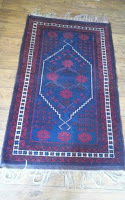
"You know, the blue one. It will fit perfectly here."
"I don't remember a blue one," he said. "What about the red one?"
"Red? What red carpet? We don't have a red one. But I'm sure the blue one will work great."
"No, the red will be better. Hold on, let me go find it and show you."
Can you tell where this is going? Can you spot the ending a mile off?
So, my dear husband returns with the exact BLUE rug I'd been talking about in his hands.
"See," he said. "Red." He pointed to the geometrical and floral designs woven in red.
"No, look," I pointed to the border and background throughout surrounding the design. "It's blue. There's more blue than red."
Blue rug / red rug. Blue states / red states. Blue character POV / red character POV.
My husband remembered the design. I remembered the background. My husband tends to focus on aesthetics, whereas I tend to focus on function.
To me, this simple dialogue demonstrated so clearly to me a simple difference between me and my husband. Because of our background and cultural differences, we have a different way of viewing the world. And quite often, as with the rug, the way we see things, while different, is not...wrong. (Though shhhh, don't tell him I said so).
In life, real conflict between people is rarely simple or easily solved. Quite often, true differences in opinion stem from a deeply based belief system that is neither right nor wrong, just different.
Well-developed characters have strong POVs. These POVs should be informed by their cultures, their personal history, their beliefs, their backstory. And to create an intense read, your characters' POVs should conflict with each other in a way not easily solved.
How much more interesting will it be to your reader if you build up a complex conflict between characters that has no clear good guy or bad guy but rather a deeply differing level of seeing and understanding their world?
So, you tell me -- is the rug red or is it blue?

Published on January 29, 2013 09:26
December 5, 2012
Guest Post: Laura Pauling on How to Research an Ancient Society for Your Fiction
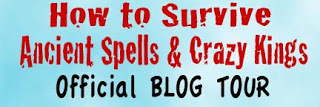
Today I am thrilled to welcome to the blog Laura Pauling as part of her Ancient Spells & Crazy Kings Blog Tour! Laura's book, along with her post, are right up my alley. Laura has managed to combine an intriguing ancient society with a compelling mystery with a couple of great middle-grade characters. Bianca is a delightfully curious girl with a tremendous amount of drive and determination to find her disappeared grandfather. She won't let a few ancient (and really scary) Mayans get in her way. One of Laura's early scenes, where Bianca first witnesses a Mayan ceremony on top of a pyramid temple (don't want to reveal too much) had me reading on the edge of my seat...and then didn't let me go until the end.
I love how Laura makes these ancient people and their society come to life, literally. I'm sure you (or your kids!) will enjoy it as well. Please join me in welcoming Laura to the blog and read how she went about researching the Mayans for Ancient Spells and Crazy Kings. Then make sure you enter her giveaway to win one of her great packages (see bottom of post)!
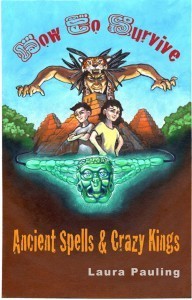
Published by Pugalicious Press
When Bianca and Melvin brave the jungle to rescue their grandfather, they stumble upon the ancient Maya city of Etza, where the people haven’t aged in 2,000 years. They must learn to work together as they face loincloth-wearing skeletons from the underworld, a backstabbing princess, and an ancient prophecy that says in three days the city will be destroyed. No problem. They’ll find Zeb and zip right out of there. The fact that a crazy king wants to serve Bianca up to the gods as an appetizer is just a minor technicality. But this ancient evil dude has finally met his match.
How to Research an Ancient Society for Your FictionOy, if only I’d known what it would take to fully understand the Maya civilization. I might have gone a different path. But I have a love of learning, especially topics that seem completely foreign to me, so I jumped in.
Research in layers. I started with a used book I bought on Amazon. I absorbed the culture of ancient Tikal and learned about the lives of kings and war. I developed plot lines that reflected the parts of their culture that fascinated me.
Start writing. I wrote the first draft then went back to fill in the holes. I also learned that the book I’d read was outdated! Yikes. So always check the publication date.
Complete more research. I went back to Amazon and this time I got smart and went through interlibrary loan for most of them. I did purchase a one-thousand-page college text. And yes, I read the whole thing and took notes on index cards, including page numbers for the facts I wrote down.
Rewrite. I rewrote, layering in the new understanding I’d gained of this culture.
Find primary resources. Yeah, this was a bit more difficult. But primary sources on ancient civilization can be found in a couple places. 1. Direct interpretation of original art. From this I learned exactly what they wore and how to describe their clothing, their intricate tattoos, and their fancy headdresses. This source also revealed more about the culture too for the Maya had many murals in their buildings. 2. Translation of a first hand witness. I read a book by a Spanish priest who saw the Maya civilization first hand. 3. Translation of their glyph writing, which I believe has been fully understood. 4. Email questions to college professors. (I didn't do this for fiction, but I would have for nonfiction.)
More research for the finer details. I searched online for first hand accounts from tourists who went where I couldn’t and walked where I couldn’t, namely Tikal National Park. I read their website and looked at pictures. I read about the region, the weather, the plants, the animals, and the jungle. I read blogs about what it felt like to be inside a temple. I perused pictures of the temples taken by many different tourists. I did this until I felt like I’d been there. And then some.
When to stop. I knew I was done when I watched a History channel special on the Maya. And I knew everything. I knew the questions before they asked them. And I knew more than they revealed on the show! Yes, I learned much more than I could ever put in the book but it’s the small details here and there that add authenticity to a story. I enjoyed every aspect of my rocky relationship to How To Survive Ancient Spells and Crazy Kings. But let’s just say I haven’t chosen such a research-intensive project since!
Thanks for letting me take over your blog for the day, Susan!
How To Survive Ancient Spells and Crazy Kings released in November. Pugalicious Press did a fantastic job, and I’m extremely happy with the results. This book would make a fantastic gift for boys or girls who enjoy adventure stories with lots of excitement! You can purchase it on Amazon or Barnes and Noble. You can read the first chapter here. Thankfully, my journey is just beginning and I’m excited to see where it leads. Click here for the list of blog tour stops! Enter to win these prize packages!
Prize Package One (signed paperbacks)
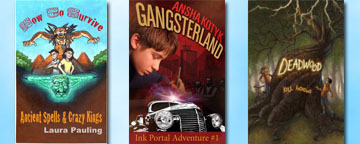 Prize Package Two (signed paperbacks)
Prize Package Two (signed paperbacks)
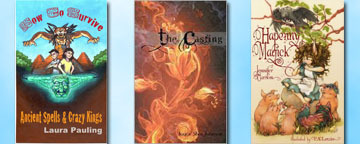 Prize Package Three
Prize Package Three

Refresh the page if you can't see the Rafflecopter form! a Rafflecopter giveaway
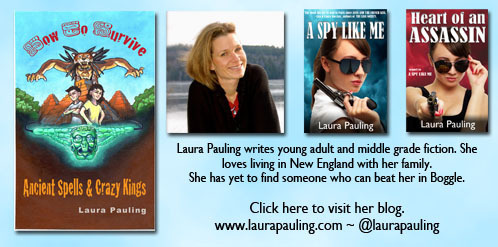
Published on December 05, 2012 05:12
December 3, 2012
Digging Up Inspiration From the Past
 Writers -- where do you get your inspiration?
Writers -- where do you get your inspiration?This is not an easy question for most of us to answer because the sources of our inspiration is ever-changing. From the people we meet, to the places we visit, to the things we read. Inspiration, like the ancient Muses, lives and breathes around us constantly.
Because of the stories I'm drawn to writing, one of my sources of inspiration is the news section on Archaeology.org. Most weekdays, someone on staff there lists snippets from current news items related to archaeology. These headlines are collected from across the world and through thousands of years of human history, even including early human ancestors.
I've not only gained whole story ideas from reading these discoveries, but more often gained valuable bits of world-building detail to help flesh out stories that I'm already working on. And these stories don't have to be historical.
For example, someone writing a paranormal romance may be very intrigued to read this article on a recently reported Medieval English skeleton with metal spikes driven through its shoulders, heart, and ankles -- a form of burial not only for suspected vampires but for social deviants. I could imagine a young, unusual heroine running afoul of her society not only because of her paranormal abilities but because of her non-conformist practices and beliefs.
Or maybe you would be inspired to write a story of a man's quest to find the cave inhabited by a Native American woman which inspired another great story -- The Island of the Blue Dolphins. Does he have some sort of psychic connection with the woman from another time period? Would his discovery pave the way for a time-traveling romance? Or perhaps, could he be a descendant?
Or maybe you could envision a contemporary romantic comedy where an eccentric Civil War collector, in cleaning his house, has to call in the bomb squad to remove some of his collection.
I could envision a whole new archaeologist-style adventure series based on the re-opening of an ancient site (Karkemish) on the Turkish-Syrian border, one littered with mines, where Lawrence of Arabia once excavated.
Maybe you'd like to write a medieval drama of a nunnery run afoul of the church due to reports of bearing children and lesbian conduct. It might be fun to create a Modern Family sort of soap opera with this unusual, historical setting.
What about a story of a youth in ancient Rome who suffered from gigantism, causing him to be at least a foot taller than all his friends. Was he revered as a Titan-like being? Or did he endure jeers from his friends?
Or perhaps one could craft a historical murder mystery out of two skeletons -- a 19-year-old woman and an older man -- found at the bottom of a Neolithic well in Israel's Jezreel Valley. Were they killed together, having been discovered in an illicit romance? Or could it have been an ancient murder-suicide?
I picked up another cool bit, but can't reveal that one here. Keeping it for myself. :-)
Writers continuously draw from bits of evidence such as these and then let their minds go wild with questions that build their worlds and their stories. But having real evidence to back up a story makes it that much more fascinating and the world building more lifelike.
So, writers -- where DO you get your inspiration? And would any of these tidbits that I find fascinating inspire you as well?
Published on December 03, 2012 08:19

